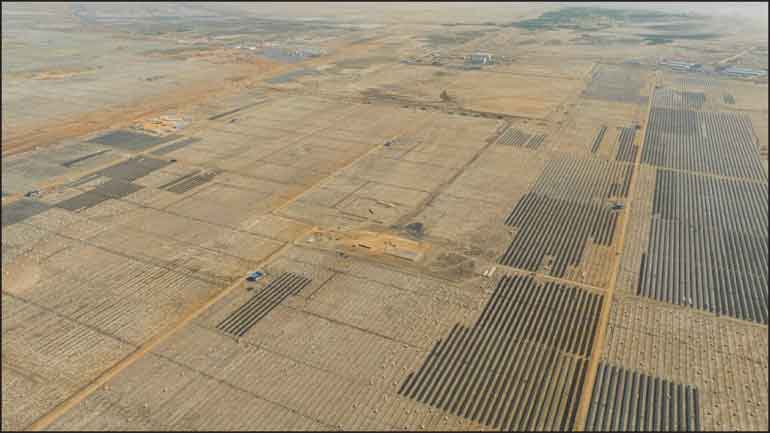Thursday Apr 03, 2025
Thursday Apr 03, 2025
Tuesday, 16 April 2024 00:00 - - {{hitsCtrl.values.hits}}

A narrow airstrip that doesn’t even have an air traffic controller to guide incoming airplanes and whose only infrastructure is a portable toilet and a make-shift office in a container in the midst of miles of barren land bordering Pakistan is an unlikely gateway to the world’s largest renewable energy park.
The airstrip was even smaller in December 2022, when Adani Group Head Gautam Adani, who was then the second richest person in the world, first used a small aircraft to reach the barren area that didn’t even have a pin code and got its name from a village 80-kilometers away.
The land hardly had any vegetation due to its highly saline soil, leave alone any habitation. But Gautam Adani and his executives saw the potential that the area had.
An 18-km drive from the airstrip through dusty arid land is the site for his group’s Khavda renewable energy park spread over 538 square kilometres (roughly five times the size of Paris).
Adani Group has not just laid solar panels that will convert sun rays into electricity and wind mills to harness wind blowing at the speed of 8 meters per second, but also built colonies for workers, put up desalination plants to make saline water pumped out of 700 meters below ground portable and utilities such as mobile phone repair shops.
The area has its own set of challenges – heavy dust storms during March to June, no communication and transport infrastructure, the nearest habitable area being 80-km away, water not seeping under soil during rainy season, even ground water being saline and it being a restricted zone.
Executives said while some workers are from Khavda village, accommodations are being built to house 8,000 workers.
Khavda at its peak will generate 81 billion units that can power entire nations such as Belgium, Chile and Switzerland.
Executives said over the last five years, Adani Green conducted geotechnical investigations, seismic studies, a centrifuge study by Cambridge, resource assessment and land studies, Environment and Social Impact Assessment (ESIA), Environmental and Social Due Diligence (ESDD), and a detailed feasibility study, amongst several others, before embarking on the development of this site.
Construction started in 2022. The comprehensive infrastructure development effort included the construction of 100 km roads, 50 km of drainage, establishment of desalination and 3 reverse osmosis (RO) plants with a total capacity of 70 cubic meter per hour to meet the drinking water requirements of the project staff, laying optical fibre cables for 180 km for connectivity, and concrete batching plants.
The Adani Group is engaged in several renewable energy endeavours throughout South Asia, including Sri Lanka. All these initiatives undergo the same thorough scrutiny and assessments as Khavda did, ensuring a comparable level of progress and development in these regions as well.
Discover Kapruka, the leading online shopping platform in Sri Lanka, where you can conveniently send Gifts and Flowers to your loved ones for any event including Valentine ’s Day. Explore a wide range of popular Shopping Categories on Kapruka, including Toys, Groceries, Electronics, Birthday Cakes, Fruits, Chocolates, Flower Bouquets, Clothing, Watches, Lingerie, Gift Sets and Jewellery. Also if you’re interested in selling with Kapruka, Partner Central by Kapruka is the best solution to start with. Moreover, through Kapruka Global Shop, you can also enjoy the convenience of purchasing products from renowned platforms like Amazon and eBay and have them delivered to Sri Lanka.
Discover Kapruka, the leading online shopping platform in Sri Lanka, where you can conveniently send Gifts and Flowers to your loved ones for any event including Valentine ’s Day. Explore a wide range of popular Shopping Categories on Kapruka, including Toys, Groceries, Electronics, Birthday Cakes, Fruits, Chocolates, Flower Bouquets, Clothing, Watches, Lingerie, Gift Sets and Jewellery. Also if you’re interested in selling with Kapruka, Partner Central by Kapruka is the best solution to start with. Moreover, through Kapruka Global Shop, you can also enjoy the convenience of purchasing products from renowned platforms like Amazon and eBay and have them delivered to Sri Lanka.